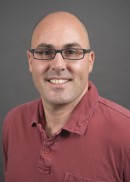Breadcrumb
Biostats student David Zahrieh brings work experience, collaboration to PhD program
By Dora Grote
Published on June 1, 2015

Trading rippling ocean waves and sunsets on the beach for patchworks of cornfields and a landlocked view wasn’t the easiest decision for David Zahrieh and his family.
Recently married with a young child, Zahrieh had a comfortable life in Boston, but his heart was set on attending the University of Iowa College of Public Health.
Fast-forward two years, and the three of them have built a wonderful life together in Iowa City, and he’s established himself within the PhD program in biostatistics.
“The department has an outstanding reputation, a favorable student to faculty ratio, and the faculty prides themselves in creating a supportive environment for students,” Zahrieh says. “Furthermore, the student and faculty diversity in the department creates a wonderful environment to collaborate and exchange ideas. It’s small, personal, and intimate.”
Bringing Work Experience to School
Before returning to school, Zahrieh worked as a biostatistician for 13 years — seven of those were spent at the Data Farber/Harvard Cancer Center in Boston. The latter six were spent at a mid-size pharmaceutical company called Shire working in clinical trials and providing statistical support in the development of orphan drugs for genetic diseases.
He graduated with his bachelor’s degree in mathematics from St. Mary’s University in San Antonio, Texas, in 1996 and then spent two years serving in the Peace Corps in Georgetown, Saint Vincent and the Grenadines, teaching mathematics to underserved and impoverished students. Subsequently, he earned his master’s degree in biostatistics at the University of Michigan in 2000.
His research interests are broad and are in the areas of biostatistics, cancer research, and statistical genetics and the analysis of high-dimensional data (e.g., a sample that can contain thousands of measurements, such as gene expression microarrays). In particular, Zahrieh is interested in the assessment and analysis of patient-reported outcomes in cancer research, clinical trial design in orphan diseases, and the modeling of subgroups and the graphical evaluation of interaction effects.
Solving Challenges Collaboratively
“I really want to be at the table collaborating and collectively solving public health and scientific challenges,” he says. “I don’t fit the oversimplified and stereotypical image of a statistician as being a solitary worker.”
As a graduate student instructor, Zahrieh has assisted with two classes, and he taught Design and Analysis of Biomedical Studies last summer. He’ll be teaching Research Data Management this fall.
Zahrieh is on track to graduate around 2018. Following graduation, he’s leaning toward going back to an environment similar to his collaborative work at Dana-Farber where he can assume more responsibility and contribute to the scientific community at a higher level.
“Admittedly, I don’t fit the image of a typical student,” he says. “I am an older student, with 13 years of professional experience as a master’s-level biostatistician, who enthusiastically enjoys spending the lion’s share of his free time playing with his bright and energetic little 3-year-old. If I can do it, most anyone can.”